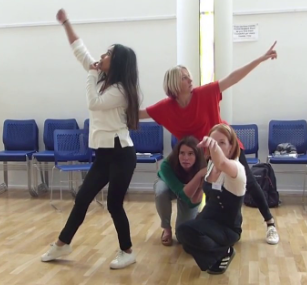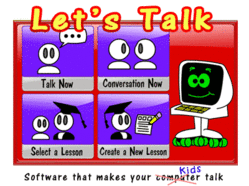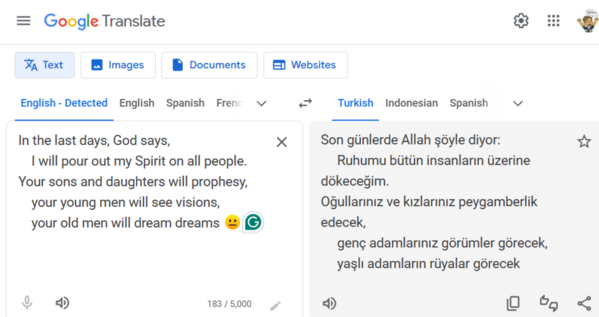Pentecost: Spirit, Wind & Flame
Lesson Set
Overview of the Workshops:
Art: Children will create origami flames that will be used in worship services on Pentecost Sunday.
Games/Bible Skills: Children will review the power the Holy Spirit gives to believers by playing a Spirit Relay. Older children will use concordances to find verses to help them in daily challenges.
Computers: Using the free Let’s Talk software, children will create a story of the disciples’ experience at Pentecost.
Drama: Children will act out six different scenes from the story.
Scripture References:
John 14:15-21 (I will send an advocate to help you)
Acts 1:1-11(Ascension, Why looking in the sky?)
Acts 2:1-47 (Story of Pentecost)
Memory Verse:
“All of them were filled with the Holy Spirit.” Acts 2:4
Theme:
Jesus’ promise to his disciples of a helper, the Holy Spirit, comes on the day of Pentecost and fills the disciples with courage and power. The Holy Spirit gives strength and courage to all believers today as well!
Lesson Objectives:
- Children will locate the story in the Bible.
- Children will retell the story in their own words.
- Children will understand the meaning of the word Pentecost.
- Children will understand that Pentecost is celebrated as the birthday of the Church.
- Children will recognize some of the symbols of Pentecost and the Holy Spirit.
- Children will recognize that the Holy Spirit is the third Person of the Trinity.
- Children will understand that the Holy Spirit gives strength and power to believers.
- Children will discuss situations where the Holy Spirit can help them.
- Children will memorize Acts 2:4.
Background Information
Festival of Passover
Jewish people celebrate a series of feasts or festivals throughout the year. The festival of Passover begins the year. It is a celebration recalling God’s mighty work in rescuing the Israelites from slavery in Egypt. Jesus was celebrating the Passover with his disciples when they ate the Last Supper together.
The Feast of Unleavened Bread
The night after Passover there is a second Jewish feast -- the Feast of Unleavened Bread. During the week following Passover, Jewish people are instructed to eat only unleavened bread. (Lev. 23:6) Leaven symbolizes sin in the Bible, so eating of unleavened bread symbolizes a holy walk with God. Jesus is the Christian symbol of unleavened bread -- without sin (leaven), born in Bethlehem (which means 'House of Bread') and often calling himself “the Bread of Life.” During the Passover meal a ceremonial “burial and resurrection” occurs with a piece of unleavened bread. This “hidden” piece of bread represents Jesus who was buried on the exact day of this feast. It’s interesting to note that Jesus died on the cross in six hours -- a much shorter amount of time than usual. (Many agonizing deaths by crucifixion took up to three days!) Jesus died in time to be buried at sundown that day -- to meet the feast of Unleavened Bread.
Feast of First Fruits
The third feast is First Fruits and is held on the Sunday following Unleavened Bread. (Lev. 23:10-11) (Remember: the Jewish Sabbath is on Saturday) It is at this feast that the Israelites acknowledged the fertility of the land by bringing the early crops of their spring planting as an offering to God.This feast has come to be called Easter in the Christian world. Recalling the Jewish name for the feast brings richer meaning to the symbolism of this feast, for this is the day when Jesus rose from the dead, as the “first fruits,” the first man permanently resurrected. Matthew 27:53 describes many graves which opened and dead people who rose and were seen after Jesus’ resurrection. Jesus was offering his Father the early crops of what will be an even greater harvest later on!
Feast of Harvest, Feast of Weeks, Shavuot (Hebrew) or Pentecost
The next feast is called the Feast of Harvest, Feast of Weeks, Shavuot (Hebrew) or Pentecost (Greek). It marks the summer harvest, the second of the year, when more crops are available. Jewish people were instructed to bring two loaves made from the wheat harvest and the harvest was dedicated to God as its giver. (Lev. 23:15-16) It is held exactly fifty days after First Fruits (Easter). Pentecost means 50 days. This is the day when the Holy Spirit came to the disciples who were waiting as instructed by Jesus. The fulfillment of this promise is in keeping with the spirit of the feast -- a greater harvest of souls (three thousand people became believers on this day). The disciples must have been amazed that Jesus, even in his death and resurrection, kept the Jewish feasts! He was crucified on Passover, buried on Unleavened Bread, raised on First Fruits, and sent the Holy Spirit on Pentecost!
Great Commission
After Jesus rose, he reappeared to his disciples for an additional forty days. Before he ascended into heaven, he gave them the Great Commission, “Go and make disciples of all nations, baptizing them in the name of the Father and of the Son and of the Holy Spirit, and teaching them to obey everything I have commanded you.” Jesus also told his disciples to stay in Jerusalem and to wait for the gift the Father would send. Jesus had told his disciples about this gift in the past. He knew that the disciples could not carry out their task without help. They needed the power of God living in them to give them strength to share Jesus’ message with the world. They needed the Holy Spirit!
Jesus’ disciples remained in Jerusalem as Jesus instructed (many Jews stayed in Jerusalem during the time between Passover and Pentecost because travel was so difficult and time consuming). They were waiting for the gift Jesus had promised. They must have felt a great deal of confusion, fear, anxiety, impatience, and perhaps even skepticism (remember doubting Thomas?).
Day of Pentecost
On the third hour (9:00 a.m.) of the day of Pentecost as the disciples were gathering for the Hour of Prayer, the Promised Gift appeared. Suddenly a great and violent “wind” seemed to blow through the Temple Courts. Tongues of fire appeared on the heads of believers. The disciples began speaking in many different languages but amazingly, those present heard the words in their own native languages. Some scoffers believed the disciples were drunk even though it was only 9:00 a.m. Peter stood up and preached a powerful message to those present, “repent and be baptized!” Baptism was traditionally reserved for pagans who were converting to Judaism, so Peter’s message was an offensive one to Jews. Despite this fact, 3000 people accepted his message and were baptized that day. (the greater harvest of souls) Large pools in the Temple area could accommodate mass baptisms.
The Early Church
These early believers were radically changed. The early Christian church banded together, often pooling their possessions and sharing everything they owned. They were adamant about valuing people over possessions. They acknowledged that Jesus owned both them and their property. Pagans ridiculed this lifestyle choice and eventually these values overwhelmed the church.
The Holy Spirit (Trinity)
The Holy Spirit is the third person of the Trinity (Father, Son and Holy Spirit). The doctrine of the Trinity is one that uniquely differentiates Christianity from the other monotheistic religions Judaism and Islam. Some Christian denominations also deny the doctrine of the Trinity (Unitarians and Jehovah’s Witnesses). The doctrine of the Trinity is an ancient and solid part of the Christian faith. Throughout Church history, many doctrines have been examined, but the teaching on the Trinity has never wavered. John Wesley began with the Trinity as the first of his 25 Articles of Religion that constitute the Methodist faith.
Understanding the Trinity is difficult. How can God be both one and three? The development of Trinitarian doctrine came as the early disciples grappled with their faith understandings and their experience. For Jews the primary faith statement is the Shema: “Hear, O Israel: The LORD is our God, the LORD is one.” (Deuteronomy 6:4) But then they experienced Jesus Christ. He showed himself to be God through his actions, his teachings, his life. He proved it to be so after his resurrection and their indwelling with the Holy Spirit. And then there was the Holy Spirit. Undeniably God was now with the disciples in a new way, just as Jesus had told them.
Ultimately the doctrine of Trinity may be simply our word for what we know to be true but cannot completely explain.
Hints of a Trinitarian understanding of God are found in the Old Testament as well. Genesis 1 states “God said, ‘Let us make humankind in our image.’” Other examples are Old Testament theophanies (appearances of God in visible form) such as the burning bush, the three men who visit Sarah and Abraham and the fourth man in the furnace with Shadrach, Meshach and Abednego.
The Holy Spirit in the Old Testament
The Holy Spirit’s activity within individuals did not just suddenly begin on Pentecost. The Old Testament refers to the Holy Spirit as “the Spirit of the Lord.” In Old Testament writings the “Spirit’s” activity is more selective, coming specifically upon certain individuals to accomplish God’s work (and then leaving). But the prophet Joel foresaw a day when God would say,
“I will pour out my spirit on all flesh;
your sons and your daughters shall prophesy,
your old men shall dream dreams,
and your young men shall see visions.
Even on the male and female slaves,
in those days, I will pour out my spirit.”
(Joel 2:28-29)
Holy Spirit in the New Testament
In the New Testament, with the coming of Jesus and the day of Pentecost, we see the Holy Spirit being available to “all flesh” in a broader, more inclusive way. God’s ultimate plan of salvation unfolds before us. The Holy Spirit is the third person of our “three-in-one” God. He is God. Like God, the Holy Spirit is eternal, present everywhere, and equal with God the Father and God the Son.
Doctrine of the Trinity
The doctrine of the Trinity tries to express the mystery of how we experience God and how God acts as Father-Creator, as Son-Jesus-Redeemer, and as the Holy Spirit-Sustainer. It's more of a confession than a precise description. It began as a revelation in the early church and among the disciples of who Jesus was -- God incarnate (in the flesh), and not merely a human messiah. Though our language is often confusing to people, especially children, when we say things like "Jesus prayed to God" (how can he pray to himself?), our language is reflecting those moments and feelings we have when we encounter God's personality (his three "persons"). We relate to him through Jesus as son/child of God just like us, and as a son showing God's children how to relate to their Father.
The Holy Spirit
In Hebrew, the word ruach means spirit, wind and breath. The “Spirit” helps to bring God closer, nearer to us, truly “God with us,” in a very intimate way. The Spirit helps us to know God. The Holy Spirit is active in our lives even before we are Christians.... this is called prevenient grace. The Holy Spirit woos us, nudges us, and draws us closer and closer to Christ. When we accept Jesus Christ as our Savior, and become a Christian (what many people call 'saved'), we are made right with God or justified. This is justifying grace. We invite God's Holy Spirit to guide us. Now the Holy Spirit has an even closer relationship with us and continues to communicate with us, gives us God’s power and helps us grow ever closer to God and more and more like Christ (the goal of the Christian life is to become like Christ!). The action of the Holy Spirit after we become Christians is a lifelong process of growing more like Jesus. This action of the Holy Spirit is called sanctifying grace. John Wesley called it “going on to perfection.”
Symbols of the Holy Spirit are wind, dove, flame. These symbols help to explain what is a difficult concept. Just as we cannot see wind, but can see its results (trees moving, leaves blowing, etc.) we cannot see the Holy Spirit, but we can feel His effects. Younger children may have difficulty understanding the concept of Holy Spirit. Explaining what the Spirit does can help with this abstract concept. For example: help the children understand that the Holy Spirit is God, giving us strength, helping us do what is right (even when it is hard), or telling us when we are doing something wrong (similar to but not synonymous with conscience). The Holy Spirit is God, guiding us and teaching us how to share God’s love with others. Just as in the time of the disciples, the Holy Spirit is in the world today, helping us. The Holy Spirit lives in the hearts of all believers in Christ. (John 14:15-21)
The dove as a symbol of the Holy Spirit recalls the baptism of Jesus when the “Spirit of God” descended on Jesus like a dove. When a dove represents the Holy Spirit it is shown with a circle of light around its head, indicating a Person of the Trinity. The flames or tongues of fire represent the flames seen above the heads of the disciples when the Holy Spirit arrived at Pentecost. The liturgical color for this day is red.
The coming of the Holy Spirit to the believers at Pentecost is often referred to as the “birthday of the Christian church.” The days marked a new beginning in the disciples’ proclamation of the risen Christ. With the coming of the Holy Spirit, the disciples felt the comfort, insight and power of God, enabling them to follow Jesus’ directive in the Great Commission -- to go and make disciples of the world!
(Some Sources: The Seven Feasts of Israel by Zola Levitt, The IVP Bible Background Commentary - New Testament by Craig S. Keener, Smith’s Bible Dictionary by William Smith, Christian Believer - Knowing God with Heart and Mind Study Manual by J. Ellsworth Kalas; I Want to Know About the Holy Spirit, Rick Osborne and K. Christie Bowler, Zonderkidz, 1998; New Invitation Bible Studies for Elementary A, B, C - Spring 1992, 93, 94, 95, 96)
Written by Jaymie Derden




 The free Let’s Talk software available to our Supporting Members. It has a number of kid-friendly and classroom friendly features. Though it only speaks in English, students will use it to "translate" the Good News into kid-friendly language.
The free Let’s Talk software available to our Supporting Members. It has a number of kid-friendly and classroom friendly features. Though it only speaks in English, students will use it to "translate" the Good News into kid-friendly language. The Let's Talk software program is available FREE OF CHARGE to the supporting members of Rotation.org.
The Let's Talk software program is available FREE OF CHARGE to the supporting members of Rotation.org. 








